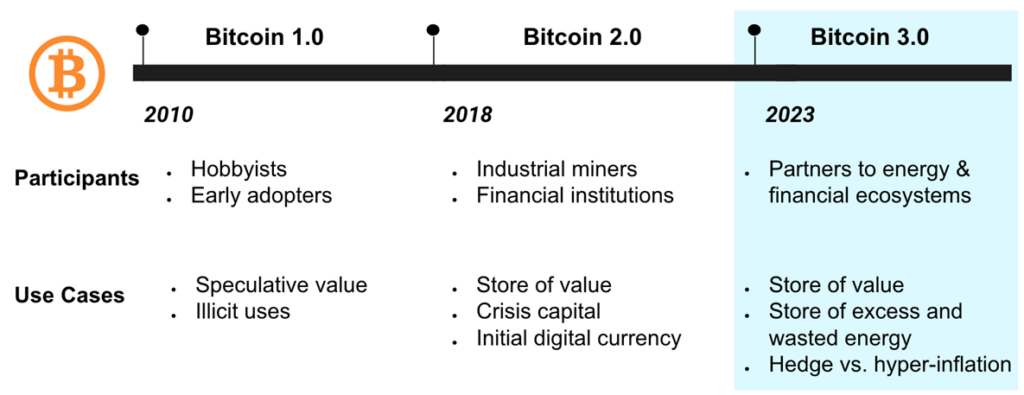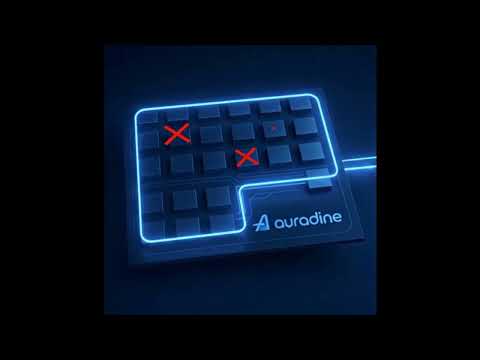By Sanjay Gupta, Head of Strategy, Auradine Inc.
Bitcoin, the first blockchain network and most popular cryptocurrency, has come a long way since its inception in 2009. What started as a niche hobby for cyberpunks and speculators has grown into a global phenomenon with increasing adoption. In order to understand the future trajectory and impact of Bitcoin, it’s important to examine the historical evolution of Bitcoin— both the technology and asset class— its breakthroughs and shortcomings, and what is necessary to reach adoption on a global scale.
In this blog, we will explore the road to “Bitcoin 3.0”, what we consider to be the near future state of Bitcoin and its potential to support the energy future of the planet. When implemented and deployed responsibly, Bitcoin mining provides capabilities that can support base energy loads, provide stability to mismatched energy demand and supply characteristics, drive the growth of renewable infrastructure, and enable grid modernization.
At Auradine, we are building the future of internet infrastructure, focusing on breakthrough scalability, sustainability and security solutions enabled by revolutionary blockchain, AI and zero-knowledge technologies. We are operating at the forefront of cutting-edge hardware and software solutions that will enable technologies like blockchain and Bitcoin to scale sustainably and achieve optimal impact worldwide.
Sustainable and scalable evolution of Bitcoin 3.0

Source: Auradine
Bitcoin 1.0: Early days – “The Hobbyist Era”
Bitcoin 1.0 refers to the early days of Bitcoin, when it was mainly used by hobbyists and speculators who were fascinated by the allure of Satoshi’s groundbreaking white paper, innovative technology, and its potential to create a decentralized, peer-to-peer, trustless form of money. Bitcoin 1.0 was characterized by trial adoption with primarily speculative use cases. At this time, while the blockchain technology that powered Bitcoin was beginning to be understood as a decentralized, trustless system, it was also exploited for illicit uses that took advantage of its anonymous and global reach as an exchange of value. Bitcoin 1.0 however laid the foundation for the subsequent crypto revolution and proved that it was possible to create a digital currency that operates without intermediaries and central authorities.
Bitcoin 2.0: Rapid mining growth “The Industrialized Mining Era”
Bitcoin 2.0 refers to the most recent phase of Bitcoin, where the days of mining in dorm rooms and basements were replaced by a rapid rise of industrial-scale miners and global hashing capacity being measured in Exahash/second (1018 hashes/second!). The Bitcoin security protocol uses a ‘proof of work’ (PoW) consensus mechanism and requires participants or ‘miners’ to validate transactions on the block approximately every 10 minutes. Successful miners earn Bitcoin block rewards in addition to any transaction fees.
When Bitcoin mining is done at scale, the needed compute speed requires large numbers of specialized ASIC-based computers. These consume significant quantities of energy, which has been an ongoing focus of considerable analysis and debate.
During this time, ideas around Bitcoin as a store of value and a legitimate asset gained increasing momentum. For example, Bitcoin was seen as a valuable means for transacting ‘crisis capital’ in situations of natural or man-made calamities, such as aid at the outset of the Ukraine war. Bitcoin is also experiencing increasing use as an exchange of value in payments for goods and services with initial merchant acceptance enablement.
Bitcoin 2.0 attracted the attention and participation of institutional investors, corporations, governments, and regulators, who saw its potential to transform the financial system.
Bitcoin 3.0: The Next Phase “Responsible Partner of the Energy and Financial Ecosystem”
Bitcoin 3.0 refers to the next evolution of Bitcoin, and, where used properly, can make Bitcoin a responsible partner of the energy and financial ecosystems.
In addition to the use cases of Bitcoin 2.0 as a store of value, the next era of Bitcoin is poised for increasing use as an exchange of value with widespread merchant acceptance. In the recent past, there has been a rise of NFT-like applications called ‘ordinals’ where data can be immutably etched onto a micro-building block of Bitcoin called a Satoshi (100 million Satoshis = 1 Bitcoin) and as a currency hedge in countries facing hyperinflation.
However, Bitcoin 3.0’s most important use can be as a store for excess and wasted energy that can support the energy future of the planet. Using large quantities of computational power is necessary to support the security aspect of Bitcoin, something that makes it robust compared to other blockchains. But this computational power can be harnessed productively, as the extent of computational power consumed can be deployed to balance the energy grid using rapid demand response, drive sustainable investment in renewable energy and reduce carbon emissions by reducing gas flaring. This is a massive breakthrough. With systems purpose-built to support Bitcoin 3.0, Bitcoin can become a responsible partner to the energy ecosystem and a strong net positive contributor to the planet in the following ways:
A. Demand response to balance the energy grid: bitcoin mining computations can be rapidly curtailed for energy demand response and grid balancing when needed. ERCOT, Texas electricity grid operator, estimated in a December 2022 report that bitcoin mining operations were able to curtail their operations and relieve roughly 1.7GW of energy during the Texas winter. On the other hand, in times of excess energy supply without corresponding demand, bitcoin mining can be a sink of energy, providing grid stability and economic value. This is especially useful for renewable energy sources like solar and wind which can have highly variable supply. With systems designed for rapid response, unlike most other industries, the bitcoin mining operations can curtail their energy consumption or increase usage in seconds based on the needs of the energy grid.
B. Driving sustainable investment in renewable energy: Clean, renewable energy requires significant capital investment in large-scale projects. Without a clear return on investment, these projects have been limited to a few geographies only often supported by government subsidies. For instance, Africa owns 40% of the globe’s potential for solar power yet it only inhabits less than 2% of the total global capacity for electricity generation of solar energy (IRENA “Renewable Capacity Statistics”, 2021). Bitcoin mining is already being powered by solar and wind energy in different parts of the world. It provides an economically viable option to invest in solar and other renewable energy sources at an industrial scale with systems that are deployable in rugged conditions and remote locations.
C. Reducing harmful gas flaring and using stranded energy: The Global Gas Flaring Research tracker (GGFR), a leading global and independent indicator of gas flaring, estimated that in 2022 gas flaring released 42 million tons in the form of methane. Methane, the primary component of natural gas, is a potent but short-lived greenhouse gas, with a warming potential much higher than carbon dioxide. Gas flaring is an extraordinary waste of economic value (as much as USD 55 billion per year at a price of USD 10 per MBtu) alongside its negative impacts on climate change and human health. Reducing flaring through Bitcoin mining reduces carbon emissions while capturing the economic value, without any additional energy consumption.
Conclusion
Bitcoin 3.0 is not a distant dream or a utopian vision for an idealistic technology. It is already happening in various forms across the world. For this to succeed further, Bitcoin mining silicon, software and system solutions need to be designed from the ground up for rapid energy demand response and be deployable in remote locations and harsh conditions at scale.
As Bitcoin 3.0 evolves, it will become more integrated and aligned with the energy and financial ecosystems, creating a more efficient, inclusive, and sustainable world. At Auradine, we are proud to be part of this evolution with ground-breaking solutions designed for this evolution of Bitcoin 3.0. If you want to learn more about Bitcoin 3.0 and how it can benefit your business and society, please contact us at media@auradine.com.


